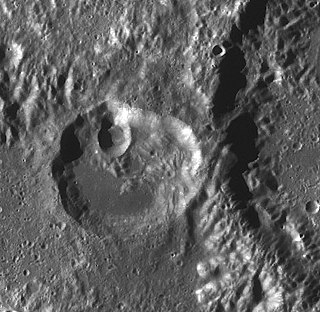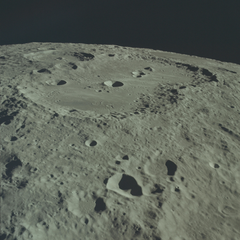
Dawes is a lunar impact crater located in the wide straight between Mare Serenitatis and Mare Tranquilitatis. To its southwest lies the larger crater Plinius, and to its northeast sits the Mons Argaeus mountain rise. It is named after British astronomer William Rutter Dawes.

Zelinskiy is a lunar impact crater that is located on the far side of the Moon. It lies nestled along the northern edge of Mare Ingenii, with the oddly shaped crater Van de Graaff along the east rim and the lava-flooded crater Thomson within one crater diameter to the south.

Censorinus is a tiny lunar impact crater located on a rise to the southeast of the Mare Tranquillitatis. It is named after the ancient Roman writer Censorinus. To the northeast is the crater Maskelyne.

Aitken is a large lunar impact crater that lies on the far side of the Moon, named for Robert Grant Aitken, an American astronomer specializing in binary stellar systems. It is located to the southeast of the crater Heaviside, and north of the unusual formation Van de Graaff. Attached to the southwest rim is Vertregt. To the southeast is the smaller Bergstrand.

Anders is a worn lunar impact crater that is located in the southern hemisphere on the far side of the Moon. It lies just to the southeast of the outer rim of the huge walled basin named Apollo. To the south-southeast is the crater Leavitt.

Ariadaeus is a small, bowl-shaped lunar impact crater on the western shores of Mare Tranquillitatis. It lies to the north of the crater Dionysius, and to the west-southwest of Arago. The crater is joined along the northeast rim by the slightly smaller Ariadaeus A, and the two form a double-crater. Its diameter is 10.4 km.

Thomson is a lunar impact crater that is located within the Mare Ingenii on the far side of the Moon. Just to the northeast is the unusual merged crater formation of Van de Graaff. On the northwest rim of the mare is O'Day, and to the south-southwest is Obruchev on the southern shore of Mare Ingenii.

Vertregt is the ancient remnant of a large lunar impact crater. It is located on the far side of the Moon, to the north of the unusual walled plain Van de Graaff. The prominent crater Aitken lies across the northeast rim of Vertregt, and Zwicky is attached to the northwestern rim.

Boyle is a lunar impact crater that is located in the southern hemisphere on the rugged far side of the Moon. It is adjacent to the larger crater Hess to the southeast, and lies about midway between the craters Alder to the north-northeast and Abbe to the south-southwest.

Dawson is a lunar impact crater that lies on the southern hemisphere on the far side of the Moon. It lies across a crater triplet: the southeast rim is intruding into the crater Alekhin; the northwest rim also intrudes into the larger satellite crater Dawson V, and the northeast rim is attached to the comparably sized Dawson D. To the south of this formation is the large crater Zeeman. West of Dawson is the crater Crommelin, and to the north lies Fizeau.

Brianchon is a lunar impact crater that is located along the northwestern limb of the Moon. Due to its location, from the Earth the crater is seen from the edge and its visibility is somewhat affected by libration. Thus for a more detailed view, the crater must be viewed from orbit.

Boltzmann is an old lunar impact crater that is located along the southern limb of the Moon, in the vicinity of the south pole. At this location the crater is viewed from the side from Earth, and so not much detail can be seen. It is located to the north of the walled plain Drygalski, and to the west of the crater Le Gentil.

Brashear is a lunar impact crater on the far side of the Moon, in the southern hemisphere in the vicinity of the south pole. The crater is named after the American astronomer John A. Brashear. It lies just to the south of the walled plain Antoniadi, within the larger crater's outer rampart of ejecta. To the northeast besides Antoniadi is the crater Numerov, and southeast lies the younger De Forest.

Birkeland is a lunar impact crater that lies in the southern hemisphere on the far side of the Moon. This crater is attached to the central waist of the oddly shaped Van de Graaff crater formation, and may partly account for that crater's figure-8 shape. To the southeast is the large walled plain Leibnitz.

van Albada is a lunar impact crater that is attached to the south-southeastern rim of Auzout. It lies southeast of Mare Crisium, and north-northeast of the larger crater Firmicus. Directly to the east is Krogh.

Leibnitz is a huge lunar impact crater that is located in the southern hemisphere on the far side of the Moon. This formation is the same size as Clavius on the near side. It is located to the east-southeast of Mare Ingenii, and is joined to the northeast rim of Von Kármán. Attached to the eastern rim of Leibnitz is Davisson, and intruding into the southeast rim is Finsen. Farther to the west is the large Oppenheimer.

Leeuwenhoek is a lunar impact crater that lies in the Moon's southern hemisphere, on the far side from the Earth. It is located to the east of the crater Birkeland and the unusual double crater Van de Graaff. To the northeast of Leeuwenhoek is Orlov and to the south is the large walled plain Leibnitz. It is named after Antonie van Leeuwenhoek.

Nassau is a lunar impact crater on the Moon's far side. It abuts against the northeastern rim of the figure-8-shaped crater Van de Graaff. To the southeast of Nassau lies the crater Leeuwenhoek, and to the east is Orlov.

Van den Bos is a small lunar impact crater that is joined to the south-southwestern outer rim of the slightly larger crater Tamm. About one crater diameter to the west is Vil'ev. Farther away to the east is the prominent Chaplygin, and to the south-southwest lies Marconi. van den Bos is located on the far side of the Moon and cannot be viewed directly from the Earth.

Nernst is a lunar impact crater that lies on the far side of the Moon, just beyond the northwestern limb. It lies across the northern part of the larger walled plain Lorentz, and intrudes slightly into the northwestern rim of the crater Röntgen.






















